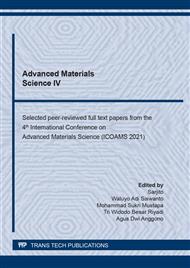[1]
R. S. Mishra and Z. Y. Ma, Friction stir welding and processing,, Mater. Sci. Eng. R Reports, vol. 50, no. 1–2, p.1–78, 2005,.
Google Scholar
[2]
A. D. Anggono, T. W. B. Riyadi, Sarjito, D. Triyoko, B. Sugito, and A. Hariyanto, Influence of tool rotation and welding speed on the friction stir welding of AA 1100 and AA 6061-T6,, AIP Conf. Proc., vol. 1977, no. June, 2018,.
DOI: 10.1063/1.5042910
Google Scholar
[3]
V. K. Mohan, M. Shamnadh, and A. Sudheer, Fabrication and Characterization of Friction Stir Welding of AA6061 Using Copper Powder,, Mater. Today Proc., vol. 5, no. 11, p.24339–24346, 2018,.
DOI: 10.1016/j.matpr.2018.10.229
Google Scholar
[4]
B. Rahmatian, K. Dehghani, and S. E. Mirsalehi, Effect of adding SiC nanoparticles to nugget zone of thick AA5083 aluminium alloy joined by using double-sided friction stir welding,, J. Manuf. Process., vol. 52, no. October 2019, p.152–164, 2020,.
DOI: 10.1016/j.jmapro.2020.01.046
Google Scholar
[5]
H. Mehdi and R. S. Mishra, Mechanical and microstructure characterization of friction stir welding for dissimilar alloy-A Review,, Int. J. Res. Eng. Innov., vol. 1, no. 5, p.57–67, 2017, [Online]. Available: http://www.ijrei.com.
Google Scholar
[6]
N. Kashaev, V. Ventzke, and G. Çam, Prospects of laser beam welding and friction stir welding processes for aluminum airframe structural applications,, Journal of Manufacturing Processes. 2018,.
DOI: 10.1016/j.jmapro.2018.10.005
Google Scholar
[7]
T. Dursun and C. Soutis, Recent developments in advanced aircraft aluminium alloys,, Materials and Design. 2014,.
DOI: 10.1016/j.matdes.2013.12.002
Google Scholar
[8]
H. A. Derazkola, A. Simchi, and F. Lambiase, Friction stir welding of polycarbonate lap joints: relationship between processing parameters and mechanical properties,, Polym. Test., vol. 79, p.105999, (2019).
DOI: 10.1016/j.polymertesting.2019.105999
Google Scholar
[9]
M. Pourali, A. Abdollah-Zadeh, T. Saeid, and F. Kargar, Influence of welding parameters on intermetallic compounds formation in dissimilar steel/aluminum friction stir welds,, J. Alloys Compd., vol. 715, p.1–8, (2017).
DOI: 10.1016/j.jallcom.2017.04.272
Google Scholar
[10]
M. Bodaghi and K. Dehghani, Friction stir welding of AA5052: the effects of SiC nano-particles addition,, Int. J. Adv. Manuf. Technol., vol. 88, no. 9–12, p.2651–2660, 2017,.
DOI: 10.1007/s00170-016-8959-8
Google Scholar
[11]
Y. F. Sun and H. Fujii, The effect of SiC particles on the microstructure and mechanical properties of friction stir welded pure copper joints,, Mater. Sci. Eng. A, vol. 528, no. 16–17, p.5470–5475, 2011,.
DOI: 10.1016/j.msea.2011.03.077
Google Scholar
[12]
D. R. Ni, D. L. Chen, D. Wang, B. L. Xiao, and Z. Y. Ma, Influence of microstructural evolution on tensile properties of friction stir welded joint of rolled SiCp/AA2009-T351 sheet,, Mater. Des., vol. 51, p.199–205, 2013,.
DOI: 10.1016/j.matdes.2013.04.027
Google Scholar
[13]
X. G. Chen, M. da Silva, P. Gougeon, and L. St-Georges, Microstructure and mechanical properties of friction stir welded AA6063-B4C metal matrix composites,, Mater. Sci. Eng. A, vol. 518, no. 1–2, p.174–184, 2009,.
DOI: 10.1016/j.msea.2009.04.052
Google Scholar
[14]
A. Garg and A. Bhattacharya, Influence of Cu powder on strength, failure and metallurgical characterization of single, double pass friction stir welded AA6061-AA7075 joints,, Mater. Sci. Eng. A, vol. 759, no. January, p.661–679, 2019,.
DOI: 10.1016/j.msea.2019.05.067
Google Scholar
[15]
S. A. Behmand, S. E. Mirsalehi, H. Omidvar, and M. A. Safarkhanian, Single- and double-pass FSW lap joining of AA5456 sheets with different thicknesses,, Mater. Sci. Technol. (United Kingdom), vol. 32, no. 5, p.438–445, 2016,.
DOI: 10.1179/1743284715y.0000000107
Google Scholar
[16]
I. HEJAZI and S. E. MIRSALEHI, Effect of pin penetration depth on double-sided friction stir welded joints of AA6061-T913 alloy,, Trans. Nonferrous Met. Soc. China (English Ed., vol. 26, no. 3, p.676–683, 2016,.
DOI: 10.1016/s1003-6326(16)64158-4
Google Scholar
[17]
S. Practice, Standard Practice for Microetching Metals and Alloys ASTM E-407,, vol. 07, no. Reapproved 2015, p.1–22, 2016,.
Google Scholar
[18]
Y. G. Kim, H. Fujii, T. Tsumura, T. Komazaki, and K. Nakata, Three defect types in friction stir welding of aluminum die casting alloy,, Mater. Sci. Eng. A, vol. 415, no. 1–2, p.250–254, 2006,.
DOI: 10.1016/j.msea.2005.09.072
Google Scholar
[19]
E. Aldanondo, E. Arruti, A. Echeverria, and I. Hurtado, Friction Stir Welding of Lap Joints Using New Al–Li Alloys for Stringer-Skin Joints. Springer International Publishing, (2019).
DOI: 10.1007/978-3-030-05752-7_8
Google Scholar
[20]
R. Chandran and S. K. V. Santhanam, Submerged friction stir welding of 6061-T6 aluminium alloy under different water heads,, Mater. Res., vol. 21, no. 6, 2020,.
DOI: 10.1590/1980-5373-mr-2017-1070
Google Scholar
[21]
D. D. I. Pantelis1,, P. N. Karakizis1, N. M. Daniolos1, C. A. Charitidis2, E. P. Koumoulos2, Dissimilar Friction Stir Welding of AA5083 with AA6082 Reinforced with SiC Particles,, p.1–41, (2019).
Google Scholar
[22]
M. Bahrami, K. Dehghani, M. Kazem, and B. Givi, A novel approach to develop aluminum matrix nano-composite employing friction stir welding technique,, J. Mater., 2013,.
DOI: 10.1016/j.matdes.2013.07.006
Google Scholar
[23]
H. Mohammadzadeh et al., Processing – structure – property correlation in nano-SiC-reinforced friction stir welded aluminum joints,, J. Manuf. Process., vol. 21, p.180–189, 2016,.
DOI: 10.1016/j.jmapro.2015.12.008
Google Scholar
[24]
E. Kristianto and A. D. Anggono, Analisis Sifat Mekanik dan Struktur Mikro pada Sambungan Las Aluminium dengan Variasi Filler Menggunakan Metode Friction Stir Welding (FSW)., Universitas Muhammadiyah Surakarta, (2017).
DOI: 10.14710/kapal.v16i3.23280
Google Scholar


